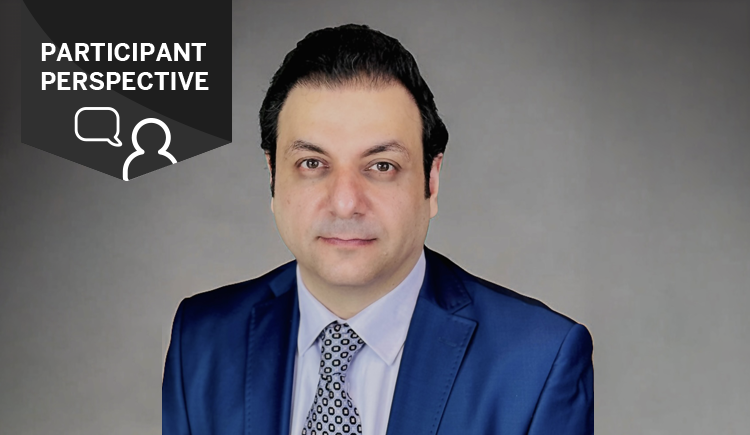
Adaptive leadership challenges almost all of the assumptions and understanding of traditional leadership, explains Ashraf Hegazy, MPA/MC, adjunct faculty for Executive/Continuing Education Programs at Harvard University, speaking to a workshop for the Leadership in Medicine: Southeast Asia program.
“There is no such thing as a leader,” says Hegazy. “Leadership is an activity, not a position. It is about mobilizing systemic change.” Everyone, regardless of their position in an organization or in a social system, is capable of—and, in fact—has to be able to exercise leadership regardless of how much authority they have.
“If you start getting seduced into thinking ’I am our leader’ you will start to make the big mistakes that will not result in lasting systemic change,” he adds.
Adaptive Leadership Requires Buy-In and Participation
Hegazy explains there are two categories of work challenges that necessitate different leadership strategies. For technical problems, the problem is clearly defined as is the solution and implementation. Those responsible for making the change are authority figures.
However, for an adaptive work challenge, the problem definition itself is not clear, nor is the solution or the implementation; they require learning. And it requires all of the stakeholders to be involved in addressing the challenge and engaging in the learning process, not just those in authority because the power of authority is not enough. And, the process requires each stakeholder to understand their role in contributing to the challenge.
“The big problem we see over and over again is that people reduce an adaptive problem to a technical problem,” Hegazy says. People may respond in the short term, but because the needed change process did not happen, the system reconfigures itself back to what it was, returning to the same problems.
Adaptive problems don't have a recipe. Instead, system level change requires innovation and experimentation to get results and the process continually needs to be refined until progress is made.
Adaptive Changes are Risky and Take Time but are Long-Lasting
The technical approach to change can be a quick fix. The adaptive approach to problem solving, by its nature, is more gradual but also more sustainable because it actually realigns the system. Moving forward, if the problem, or one similar to it, resurfaces, the system has the capacity and experience to address it meaningfully. As such, those who are unfamiliar with adaptive versus technical solutions have a strong bias towards technical solutions because adaptive solutions are difficult and risky.
“One of the things to think about early on when faced with a problem is knowing when to choose a technical response and recognizing when it requires an adaptive solution,” says Hegazy.
On the ROAD to Systemic Change
People don’t resist change; they resist loss. They will only engage with significant change when they become uncomfortable enough.
In the well-known comfort zone, people do not need to engage with change. But a threshold of learning separates the comfort level beyond which people will adapt and change. To do so, their stress level has to be high enough that the stress of staying in the status quo is higher than they would feel going through systemic change. “But there’s a limit of tolerance beyond which people will not adapt to change because they are unwilling to accept the losses involved. Instead, they may reach for easy, sometimes dangerous solutions, in attempts to reduce stress,” explains Hegazy. “Instead of looking for meaningful solutions together, people may disengage from the problem or look for others to tell them what to do.”
To achieve deep transformational change, one needs to operate in the fairly large sweet spot that exists in between the comfort zone and below the limit of tolerance, which Hegazy describes as the ROAD, or Range Of Adaptive Disequilibrium.
“Part of the leadership challenge is to mobilize your system to get above the threshold of learning, so people engage with change, and then keeping them on the ROAD long enough to actually make progress in this long term process.”
Helping People Move to Where They Need to Be
The services provided by authority figures include providing direction of the organization, internal order, protection from dangers outside of the system, and a recognized level of expertise.
“But these services have nothing to do with leadership,” says Hegazy. “One can have authority for decades and never once engage in truly adaptive leadership.”
In contrast, adaptive leadership is needed when the challenges along the way are unknown and often lack a clear solution.
“Leadership is helping people move from where they are to where they need to be,” explains Hegazy. “It’s about helping others, it’s not taking charge. People need to take active steps to move from where they are to where they need to be despite the losses they will incur.”
Characteristics of Adaptive Leadership
- It is an activity anyone can engage in.
- Can be done with or without authority to mobilize people around a common problem.
- It is not based on personality, specific knowledge, or position.
- Not value-free. It is about ethics and values, to be anchored in what is best for the system as a whole.
- It’s dangerous. Adaptive leaders will at times fail, even potentially get kicked out of the system. It’s important for leaders to develop ways to anchor themselves to sustain their work over time.
Steps for Exercising Adaptive Leadership
When an adaptive change is needed, Hegazy makes several suggestions for putting it in practice.
- Identify the adaptive challenge, frame key questions and issues. Provide some direction but do not think you know the entire path.
- Disorient current roles; resist orienting people too quickly to new roles.
- Expose conflict when a problem arises; protect those who are bringing the problem to the surface.
- Challenge the norms or let them be challenged.
- Disclose external threats to the system to collectively address them; don’t hide them or address problems individually.
- Work with the group to co-develop new competencies that are needed.
Focus on the Vision and the Purpose
“People have to trust you in order to let you lead, and they do that when you fulfill their expectations for service,” says Hegazy. “But leading requires raising questions that may conflict with those expectations, risking trust.”
What is the way forward? Focus on the vision and purpose, the expected output of the change, and why the organization should engage in the pain of change and accept certain losses, says Hegazy. “The potential rewards and sense of purpose, the destination at the end of the journey, needs to be promising enough that people are willing to accept the losses of the process.”
Written by Alice McCarthy


